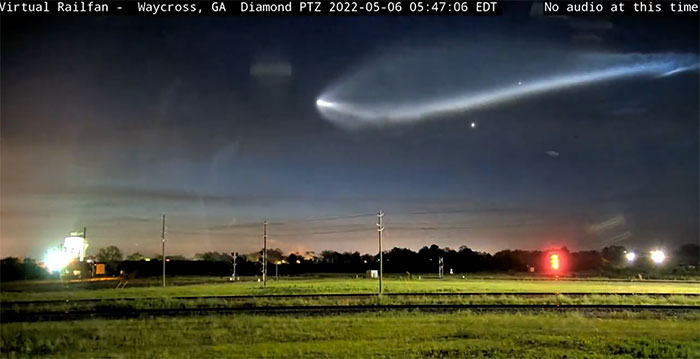In the early hours of May 5, a camera in Waycross, Georgia, witnessed a mysterious object streaking across the sky.
Bright, fast, and trailing a long glowing halo, the object appeared somewhat like a jellyfish from outer space, as Chris Combs, a professor of aerodynamics and mechanical engineering at the University of Texas in San Antonio, noted.

Camera captured an image of the jellyfish in the Georgia sky on May 5.
Of course, as Combs pointed out, “this cosmic jellyfish” is not a UFO, but rather a SpaceX Falcon 9 rocket launched from the Kennedy Space Center in Florida, approximately 400 kilometers to the south of the camera.
Dozens of rockets are launched from Kennedy each year, but very few can be mistaken for a bioluminescent invertebrate in the sky. So, what exactly happened here?
According to Combs, it was a perfect combination of physics and timing.
The long, speckled “body” of the jellyfish was simply exhaust gases escaping from the rocket engine nozzle of the Falcon 9. The reason the exhaust has that shape is due to the pressure difference inside and outside the nozzle. In this case, the exhaust leaving the nozzle was “under-expanded” — meaning the gas was at a higher pressure than the surrounding air when it exited the engine’s nozzle.
Combs explained that to match the surrounding ambient pressure in the atmosphere, the rocket exhaust reduces its own pressure by expanding right after it leaves the nozzle.
This explains the color specks. But what about the light?
Combs stated that this is much simpler than it sounds — it just depends on timing. Because the rocket launch occurred just before dawn on Thursday (around 5:45 AM local time), sunlight coming from above the horizon illuminated the exhaust, making it glow brightly against the dark sky.
Physics combined with perfect timing resulted in the sighting of what appeared to be a cosmic jellyfish.
Of course, if you want to see a real cosmic jellyfish, you would need to look a bit further into space — precisely about 300 million light-years away, not far from the galaxy cluster A2877.
Recently, astronomers observed an object with radio telescopes and saw the ghostly outline of a jellyfish swimming through distant space. That large jellyfish in the sky was also the result of a massive gas explosion — in this case, a significant outburst from ancient black holes.


















































